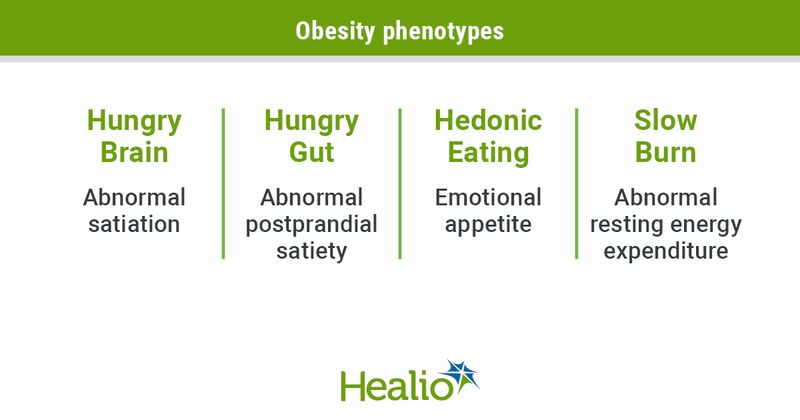Phenotype-based therapy leads to greater weight loss in obesity
A personalized obesity treatment plan based on phenotypes resulted in greater weight loss than standard of care, according to a speaker at ObesityWeek Interactive.

“We have classified obesity based on pathophysiology and behavioral phenotypes in abnormal satiation (hungry brain), abnormal postprandial satiety (hungry gut), emotional hunger (hedonic eating) and abnormal resting energy expenditure (slow burn),” Andres Acosta, MD, PhD, ABOM, assistant professor of medicine at Mayo Clinic, told Healio. “Selecting the anti-obesity medications based on the abnormal phenotype of each patient enhances weight loss 1.75 times when compared to standard of care selection of medications. Additionally, phenotype-guided use of anti-obesity medications resulted in 79% of patients losing more than 10% of total body weight compared to only 35% of patients in the nonphenotype anti-obesity medication group.”

Obesity phenotypes
Acosta and colleagues used various methods to categorize 450 study participants (mean age, 39 years; 72% women; 93% white) into four phenotypes. “Hungry brain” was measured using kilocalories consumed at an ad libitum buffet meal and a visual analog scale measuring satisfaction 30 minutes after a meal. “Hungry gut” was calculated through a visual analog scale measuring fullness 2 hours after a meal and gastric emptying time after a meal. “Emotional hunger” combined the score of an eating factor questionnaire focused on emotional restraint and the anxiety level through the hospital anxiety depression scale. “Slow burn” was measured through predicted residual energy expenditure, self-reported number of steps and self-reported exercise. All data were collected during a “phenotype day” at the Mayo Clinic.
Participants were categorized into a phenotype if they were measured in the 75th percentile or higher from the median value of the study cohort. Different median values for each phenotype were used for men and women.
In the study cohort, 18% fell into the hungry gut phenotype, 16% were categorized as hungry brain and 12% each were placed into emotional hunger and slow burn phenotypes. About 27% of participants were categorized into multiple phenotypes, and 15% had an unknown phenotype.
Personalizing obesity treatment
Acosta and colleagues also conducted a pragmatic trial in which participants were randomly assigned to phenotype-guided treatment (n = 68; 68% women; mean age, 42 years) or standard of care (n = 200; 75% women; mean age, 49 years).
Those assigned to the phenotype-guided practice were prescribed a treatment plan including lifestyle intervention featuring a diet tailored to each phenotype, medication, devices and surgery. The hungry brain strategy included phentermine/topiramate extended-released (Qsymia, Vivus), a vagal nerve block, an endoscopy sleeve gastroplasty and laparoscopic sleeve gastrectomy. Those in hungry gut received liraglutide (Saxenda, Novo Nordisk) and intragastric balloons and gels and underwent Roux-en-Y gastric bypass. The emotional hunger strategy employed an intervention diet, behavioral therapy and naltrexone/bupropion (Contrave, Currax). The slow burn phenotype participated in an intensive exercise plan in addition to a diet and were prescribed phentermine.
“Our aim was to characterize the obesity phenotypes and assess the efficacy of phenotype-guided, anti-obesity medication compare to nonphenotype pharmacotherapy,” Acosta said during the presentation. “Our long-term goal is to develop a personalized approach to obesity management.”
After 12 months, 79% of the phenotype group had a 10% or greater weight loss vs. 35% in the nonphenotype group (P < .001). The mean weight loss at 12 months was 16.1% in the phenotype cohort and 9.2% in the nonphenotype group (P < .001).
Acosta said the findings have several clinical implications that could change the way providers prescribe medication for individuals with obesity.
“First, patients with obesity will lose almost two times more weight [with phenotype-guided therapy] in 1 year,” Acosta told Healio. “Second, providers will improve their respond rate of patients losing more than 10%, to 80%, which will enhance the outcomes and compliance with patients, patient satisfaction and overall obesity and comorbidities improvement. Third, we will stop the current standard of care, which is based on trial and error, and we move toward a precision of medicine approach to select medications based on abnormal pathophysiological and behavioral phenotypes.”


